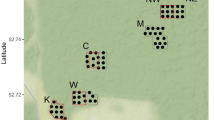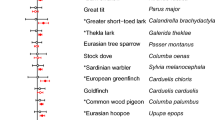Abstract
Distance sampling (DS) and territory mapping (TM) are globally applied bird survey techniques. However, specifically designed studies comparing results of both methods in different habitats in the framework of a scientific experiment have rarely been conducted. To provide a more generalized guidance for the field surveyor, here we evaluated estimates of bird abundances and number of bird species in four different habitats (broad-leaved forest, coniferous forest, open woodland and farmland) in central Germany. Abundances were estimated in parallel by TM and DS in 2006 and 2008, following standard protocols. Detection probability differed significantly among habitats and species. Density estimates by DS were in total 24% lower than those estimated by standardized TM. While the number of bird species detected with both methods was approximately the same, the estimated abundances of 15 bird species showed significant differences. Increasing the number from two to four and five registrations to count a territory by using TM decreased the density on average about 28 and 42%, respectively. Using standardized TM resulted in an overestimation of abundances of species showing a high detection probability. In contrast, DS estimated very high densities for species that had a very low detection probability. In fact, a highly negative correlation was found between the density estimated by DS and the detection probability. Using standardized TM and setting a fixed number of registrations before a location qualifies for a bird territory cannot compensate for the large differences in species detectability. Instead, the number of registrations required to count a territory should be adjusted to differences in detection probabilities and seasonal activity. From our results we can recommend a mean of four registrations if eight visits were conducted to count a territory. However, the lack of any statistically-based quality assessment reduces the serious usability of TM for estimating densities for science-based management application, whereas, the clear advantage of DS is that it provides error estimates and considers differences in species detectability.
Zusammenfassung
Distance Sampling (DS) und Revierkartierung gehören zu den verbreitetsten Erfassungsmethoden von Vogelbeständen weltweit. Bisher gibt es kaum Studien bei denen im Rahmen eines wissenschaftlichen Experiments beide Methoden parallel durchgeführt und die Ergebnisse verglichen wurden. Ziel der im Jahr 2006 und 2008 im Hohen Vogelsberg, Hessen durchgeführten Untersuchung war es deshalb, jeweils die Artenanzahl und die Abundanzen von Vögeln sowohl mit DS als auch mit der Revierkartierung in vier unterschiedlichen Lebensräumen (Laubwald, Nadelwald, Halboffenland und Offenland) standardisiert zu erfassen und zu vergleichen. Die Erfassungswahrscheinlichkeit unterschied sich deutlich zwischen den Lebensräumen und zwischen den Vogelarten. Die Dichten, die mit Hilfe von DS erfasst wurden, fielen im Durchschnitt um 24% niedriger aus im Vergleich zu den mit der Revierkartierung ermittelten Dichten. Während die Anzahl der ermittelten Arten bei beiden Methoden in etwa gleich war, zeigten die Abundanzen von 15 Arten signifikante Unterschiede. Bei der standardisierten Revierkartierung wurde ein Revier nur dann gezählt, wenn mindestens zwei Registrierungen der Art erfolgten. Steigert man die Anzahl der notwendigen Mindestregistrierungen auf vier bzw. fünf reduzierte sich die Dichte im Durchschnitt um 28% bzw. 42%. Die standardisierte Revierkartierung führte zu einer Überschätzung der Bestände von Vogelarten mit einer hohen Erfassungswahrscheinlichkeit. Im Gegensatz hierzu wurden mit DS sehr hohe Dichten für Arten mit geringer Erfassungswahrscheinlichkeit ermittelt. Dies verdeutlicht die festgestellte negative Korrelation zwischen Dichte und Erfassungswahrscheinlichkeit. Die Verwendung der Revierkartierung mit einer fixen Anzahl von Mindestregistrierungen zur Zählung eines Reviers wird den unterschiedlichen Erfassungswahrscheinlichkeiten zwischen den verschiedenen Vogelarten nicht gerecht. Daher empfiehlt sich ein artspezifisches Vorgehen unter Berücksichtigung der Erfassungswahrscheinlichkeit und der saisonalen Aktivität. Unsere Ergebnisse zeigen, das zur Wertung eines Reviers im Durchschnitt vier Registrierungen eines Vogels bei acht Begehungen notwendig sind, um realistischere Abundanzen zu erhalten. Das Fehlen jeglicher statistischer Angaben zur Bestimmung der Erfassungsgüte bei der Revierkartierung reduziert deren Eignung, um wissenschaftlich fundierte Aussagen zu erhalten. DS bietet dagegen den großen Vorteil, dass es zu jeder berechneten Abundanz Konfidenzintervalle und den jeweiligen Fehler liefert.


Similar content being viewed by others
References
Barraclough RK (2000) Distance sampling: a discussion document produced for the Department of Conservation. Science & Research Internal Report 175, Wellington
Best LB (1975) Interpretational errors in the “mapping method” as a census technique. Auk 92:452–460
Bibby CJ, Burgess ND, Hill DA, Mustoe S (2000) Bird census techniques, 2nd edn. Academic, London
Buckland ST (2006) Point transect surveys for songbirds: robust methodologies. Auk 123:345–357
Buckland ST, Anderson DR, Burnham KP, Laake J-L, Bochers DL, Thomas L (2001) Introduction to distance sampling: estimating abundance of biological populations. Oxford University Press, New York
Buckland ST, Anderson DR, Burnham KP, Laake JL, Borchers DL, Thomas L (eds) (2004) Advanced distance sampling. Oxford University Press, Oxford
Buckland ST, Marsden SJ, Green RE (2008) Estimating bird abundance: making methods work. Bird Conserv Int 18:S91–S108
Casagrande DG, Beissinger SR (1997) Evaluation of four methods for estimating parrot population size. Condor 99:445–457
DeSante DF (1986) A field test of the variable circular-plot censusing method in a Sierran Subalpine Forest habitat. Condor 88:129–142
Diefenbach DR, Brauning DW, Mattice JA (2003) Variability in grassland bird counts related to observer differences and species detection rates. Auk 120:1168–1179
Dornbusch M, Grün G, König H, Stephan B (1968) Zur Methode der Ermittlung von Brutvogel-Siedlungsdichten auf Kontrollflächen. Mitt IG Avifauna DDR 1:7–16
Finck P (1990) Seasonal variation of territory size with the little owl (Athene noctua). Oecologia 83:68–75
Gale GA, Round PD, Pierce AJ, Nimnuan S (2009) A field test of distance sampling methods for a tropical forest bird community. Auk 126:439–448
Gates CE (1979) Line transect and related issues. In: McCormack RM, Patil GP, Robson DS (eds) Sampling biological populations. International Co-operative, Fairland, pp 71–154
Gerß W (1984) Automatische Revierabgrenzung bei Siedlungsdichteuntersuchungen. J Ornithol 125:189–199
Gillings S, Fuller RJ, Henderson ACB (1998) Avian community composition and patterns of bird distribution within birch-heath mosaics in north-east Scotland. Ornis Fenn 75:27–37
Knapton RW, Krebs JR (1974) Settlement patterns, territory size, and breeding density in the song sparrow (Melospiza melodia). Can J Zool 52:1413–1420
Marques TA, Thomas L, Fancy SG, Buckland ST (2007) Improving estimates of bird density using multiple covariate distance sampling. Auk 124:1229–1243
McShea WJ, Rappole JH (1997) Variable song rates in three species of passerines and implications for estimating bird populations. J Field Ornithol 68:367–375
Newson SE, Evans KL, Noble DG, Greenwood JJD, Gaston KJ (2008) Use of distance sampling to improve estimates of national population sizes for common and widespread breeding birds in the UK. J Appl Ecol 45:1330–1338
Norvell R, Howe F, Parrish J (2003) A seven-year comparison of relative-abundance and distance-sampling methods. Auk 120:1013–1028
Pacifici K, Simons TR, Pollock KH (2008) Effects of vegetation and background noise on the detection process in auditory avian point-count surveys. Auk 125:600–607
Pasinelli G (2000) Oaks (Quercus sp.) and only oaks? Relations between habitat structure and home range size of the middle spotted woodpecker (Dendrocopos medius). Biol Conserv 93:227–235
Raman TRS (2003) Assessment of census techniques for interspecific comparisons of tropical rainforest bird densities: a field evaluation in the Western Ghats, India. Ibis 145:9–21
Robbins CS (1981) Effect of time of day on bird activity. In: Ralph CJ, Scott JM (eds) Estimating numbers of terrestrial birds. Studies in Avian Biology, vol 6, pp 275–286
Ronconi RA, Burger AE (2009) Estimating seabird densities from vessel transects: distance sampling and implications for strip transects. Aquat Biol 4:297–309
Royle JA, Dawson DK, Bates S (2004) Modeling abundance effects in distance sampling. Ecology 85:1591–1597
Scheffer M (1987) An automated method for estimating the numbers of bird-territories from an observation map. Ardea 75:231–236
Schieck J (1997) Biased detection of bird vocalizations affects comparisons of bird abundance among forested habitats. Condor 99:179–190
Somershoe SG, Twedt DJ, Reid B (2006) Combining breeding bird survey and distance sampling to estimate density of migrant and breeding birds. Condor 108:691–699
Südbeck P, Andretzke H, Fischer S, Gedeon K, Schikore T, Schröder K, Sudfeldt C (2005) Methodenstandards zur Erfassung der Brutvögel Deutschlands. Radolfzell, Germany
Svensson S (1974) Interpersonal variation in species map evaluation in bird census work with the mapping method. Acta Ornithol 14:322–338
Tarvin KA, Garvin MC, Jawor JM, Dayer KA (1998) A field evaluation of techniques used to estimate density of blue jays. J Field Ornithol 69:209–222
Thomas L, Buckland ST, Rexstad E, Laake JL, Strindberg S, Hedley SL, Bishop JRB, Marques TA (2009) Distance software: design and analysis of distance sampling surveys for estimating population size. J Appl Ecol, doi:https://doi.org/10.1111/j.1365-2664.2009.01737.x
Walters C (1986) Adaptive management of renewable resources. Blackburn, Caldwell
Witham JW, Kimball AJ (1996) Use of geographic information system to facilitate analysis of spot-mapping data. J Field Ornithol 67:367–375
Acknowledgments
Our study was funded by the German Science Foundation (DFG) within the ‘Sonderforschungsbereich 299.’ We are grateful to all colleagues working in this project for continuous discussion and support. Especially, we would like to thank M. Spiegel for conducting the fieldwork. E. Green, S. Oppel, G. Ritchison, and two anonymous reviewers kindly provided helpful comments on the manuscript. The study complies with the current laws of Germany.
Author information
Authors and Affiliations
Corresponding author
Additional information
Communicated by F. Bairlein.
Rights and permissions
About this article
Cite this article
Gottschalk, T.K., Huettmann, F. Comparison of distance sampling and territory mapping methods for birds in four different habitats. J Ornithol 152, 421–429 (2011). https://doi.org/10.1007/s10336-010-0601-1
Received:
Revised:
Accepted:
Published:
Issue Date:
DOI: https://doi.org/10.1007/s10336-010-0601-1




